Knock John Fort was built by the Royal Navy during the Second World War in the North Sea, some eighteen miles off Southend, Essex, as an anti-aircraft post. It featured in the headlines in
October 1965 when newspapers reported that two rival groups connected with offshore radio were battling over its possession. One team was from Radio City. They were already operating successfully
from the neighbouring Shivering Sands Fort but had landed some £3,000 worth of gear on Knock John. They claimed that they wanted to use the fort as a test-bed for new equipment but, as Radio City was at that time involved in
merger talks with Radio Caroline, it is more likely that they simply planned to start a new station on Knock John once the Shivering Sands deal was completed.
A week later Essex fisherman-turned-businessman Roy Bates led a group of men onto the temporarily deserted fort and took it over. He had plans for his own station, Radio Essex, and he declared squatters' rights. Quite naturally
City was not prepared to lose its equipment and a feud developed between the two stations. Possession of the fort alternated between the two, with each side launching attacks on the other, and even kidnapping the opposing men.
The squabbling went on for a month but eventually a settlement was reached: City got back its equipment; Roy Bates won possession of the fort and got to start Radio Essex.

Radio Essex car sticker.
|
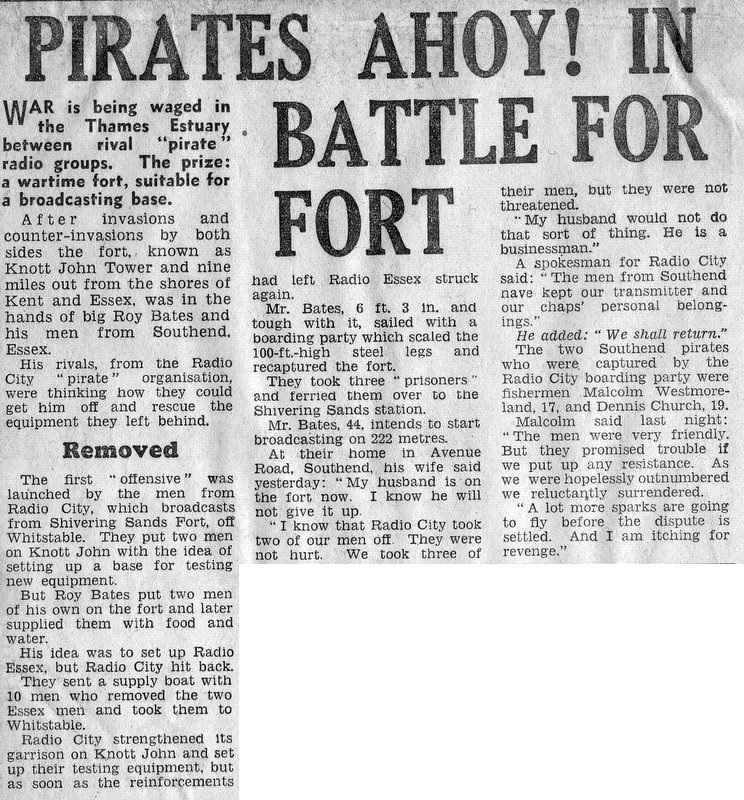
|
|
Men working for Reg Calvert and Roy Bates battling for possession of Knock John fort (not “Knott John”). This cutting from ‘The People’ 10th October 1965 kindly provided by Mike Lewis. More coverage
of this story here and here.
|
The Knock John fort consisted of a four storey platform on two hollow cylindrical sea-based legs. These contained the living quarters. Long-deserted, the fort had been ransacked by vandals. Brass port-hole surrounds,
electric light switches and the holders from the fuse board had been removed, as had all toilet and washing facilities. However it was dry, solid, and there was plenty of space. The crew was convinced that the fort was haunted but,
if there was a ghost, he or she seemed benevolent.
One of the early staff appointments was that of Richard Palmer. He had read about plans for the station in a local paper and, keen to become a pirate, tracked Roy Bates down and offered his services.
With a brand new engineering degree, Palmer was to prove invaluable when he managed to renovate the old war-time generators and get the original lighting working. He was appointed Fort Captain. Transmitter engineer
Brian Roberts had the job of coaxing as much power as possible out of the former ex-USAF radio beacon which was being used as the station's transmitter.
Other early members of the team included Vince Allen who was appointed Programme Director and the young Mark West, fresh from school and a member of a pop group that
Vince had been managing.
With no outside investors, budgets were tight. An aerial was constructed by stringing a copper wire from the anti-aircraft gun on top of the fort to a scaffolding array and a small storeroom was converted into a studio.
The broadcasting and living quarters were all housed in the same leg of the fort, with just the generator in the other one. This kept the problems of noise and vibration to a minimum.
 Vince Allen, from the early days of Radio Essex, describing the station and listing the members of the DJ team. Recording kindly donated by Nigel Fell (duration 1 minute 51 seconds)
Vince Allen, from the early days of Radio Essex, describing the station and listing the members of the DJ team. Recording kindly donated by Nigel Fell (duration 1 minute 51 seconds)
Life aboard Knock John was spartan. There was only salt water for washing - and no way of heating it. Servicing the fort in rough weather could be very difficult. There was always the danger that the
supply ship might be smashed against the side of the fort. As a result the DJs frequently ran short of food and drink, and, on at least one occasion, were forced to use the water supply left by the troops when they abandoned the
fort years earlier, despite the rotting sea-bird carcases floating in it. No alcohol was allowed, and, initially, no television. Mr Bates felt that it would be a distraction.
Radio Essex was the smallest of all the offshore stations and, when it started, broadcast with a power of just 25 watts. Tests got going at the end of October 1965 and regular transmissions began on 7th November on 1353
kilohertz, 222 metres. The scaffolding structure was always liable to collapse which meant, on occasions, an even less efficient aerial but the signal could be heard clearly over Essex and beyond.
|

|
|
Advertising the Essex Beat Club.
|
 Early Radio Essex DJ Guy Vernon (duration 34 seconds)
Early Radio Essex DJ Guy Vernon (duration 34 seconds)
 Another early DJ, Mike Curtiss, with Vince Allen in party mood at Christmas 1965. Recording kindly provided by Martyn Webster (duration 2 minutes 30 seconds)
Another early DJ, Mike Curtiss, with Vince Allen in party mood at Christmas 1965. Recording kindly provided by Martyn Webster (duration 2 minutes 30 seconds)
 An un-named Radio Essex DJ (is it Richard Palmer?) minds the shop while Vince Allen and Mike Curtiss are on shore-leave in early 1966. Recording kindly provided by Chris Stewart (duration 57 seconds)
An un-named Radio Essex DJ (is it Richard Palmer?) minds the shop while Vince Allen and Mike Curtiss are on shore-leave in early 1966. Recording kindly provided by Chris Stewart (duration 57 seconds)
|
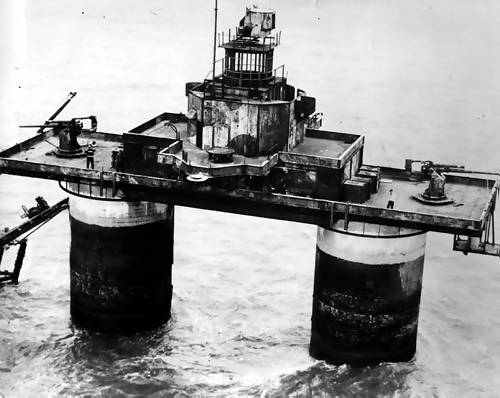
|
|
Knock John fort. Photo kindly provided by David Sinclair. More of his Radio Essex photos here.
|
A team of presenters came together. Being a small concern, DJs who had other practical skills to offer were always welcome. John Knight and Michael Cane, for instance, had very
useful catering experience.
With a philosophy of playing middle-of-the-road music by day, pop at night, the station started to build a following. In January 1966, 24 hour a day broadcasting began, the only station in Europe at that time to continue right
through the night. It was a hard life. Vince Allen's successor as programme chief Chris Stewart remembers: “I used to go on the air at eleven o'clock at night through until six in the morning. I
would then sort out news and weather for the guy doing the show from six until nine. At nine o'clock I'd go back on the air until midday. As Programme Controller I would then do administration through until six in the
evening. Go to bed at six, get up again at nine, cook myself something to eat, and get back on the air for eleven!” Not surprisingly, Chris had to leave Radio Essex, suffering from exhaustion. (Chris tells more stories from
his time on Radio Essex here.)
 Michael Cane ending an edition of The Good Morning Show on Radio Essex. The voice on the advert at the start of the clip belongs to sales director Harry Putnam. Recording kindly provided
by Michael (duration 1 minute)
Michael Cane ending an edition of The Good Morning Show on Radio Essex. The voice on the advert at the start of the clip belongs to sales director Harry Putnam. Recording kindly provided
by Michael (duration 1 minute)
| TYPICAL RADIO ESSEX PROGRAMME SCHEDULE |
6.00am “The Get Up and Go Type Show”
9.00 “The Good Morning Show”
12.00pm “An Afternoon Spin”
3.00 “The Sound of Music”
6.00 “The Big Band Show”
7.00 “Essex Goes Pop”
8.00 “An Evening with Essex”
11.00 “Essex Beat Club”
3.00am “Night Owl” (-6.00)
Information from Offshore Radio by Gerry Bishop, published by Iceni Enterprises.
|
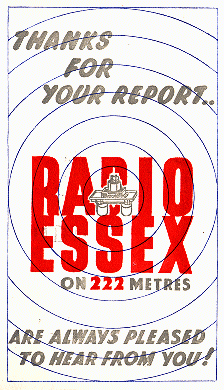
Radio Essex QSL card.
|
The presenters were all new to radio. Many came straight from school or soon after leaving. David Sinclair discovered the station after reading this article about Richard Palmer in
The Orpington & Kentish Times. The DJs were by no means richly rewarded for the hardships they had to endure on Knock John but it was a good training ground and, having learnt their craft, many of them went on to
better-paid jobs on bigger stations. (Guy Hamilton writes about his time on Radio Essex here.)

|

|
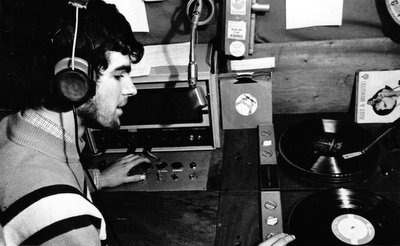
|
Left to right: Guy Hamilton, Mark West and Roger Scott in the Radio Essex studio. Photos taken by Martin Stevens and kindly provided
by George Morris.
|
Using such low power Essex obviously could not hope to capture a large audience but it claimed 30,000 listeners in and around the county. The station carried local news and advertising and was largely funded
by a campaign for Channel Airways, an airline based at Southend Airport. Radio Essex carried none of the American evangelical programmes which filled the air-time, and the coffers, of other stations. Instead, local shops and
businesses could buy 30 seconds of peak time for as little as £8-50. The commercials were often tagged with the strapline “.....and that's in Essex, of course” to emphasise the local nature of the station. Its
late night programmes found an audience much farther afield as after midnight the signal travelled well into Scandinavia.
|
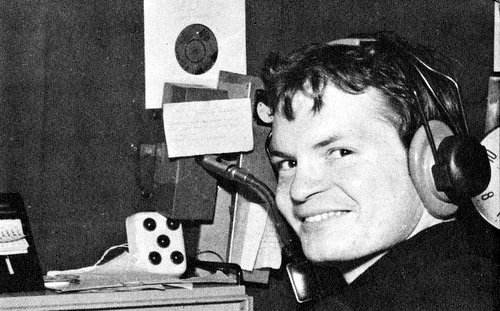
|
|
David Sinclair. Photo from ‘Who's Who In Pop Radio’, published by Four Square.
|
 Mark West on an undated edition of Essex Goes Pop probably from around August 1966 with interruptions from Guy Hamilton. Recording kindly provided by Guy (duration 3 minutes 54 seconds)
Mark West on an undated edition of Essex Goes Pop probably from around August 1966 with interruptions from Guy Hamilton. Recording kindly provided by Guy (duration 3 minutes 54 seconds)
 David Sinclair on Radio Essex's Big Band Show from 8th September 1966. Recording kindly provided by David (duration 2 minutes 43 seconds)
David Sinclair on Radio Essex's Big Band Show from 8th September 1966. Recording kindly provided by David (duration 2 minutes 43 seconds)
 A studio recording of an edition of An Evening With Essex, hosted by David Sinclair. The voice at the start is Roger Scott, the one at the end is Guy Hamilton and, in between, an hour of David who kindly provided the
recording (duration 2 minutes 36 seconds)
A studio recording of an edition of An Evening With Essex, hosted by David Sinclair. The voice at the start is Roger Scott, the one at the end is Guy Hamilton and, in between, an hour of David who kindly provided the
recording (duration 2 minutes 36 seconds)
The income was modest but, being based on a fort, the station was cheaper to run than the larger ship-based operations and Roy Bates was ambitious. For a time he considered launching a sister station, Radio Kent,
to operate from Tongue Sands Fort, off Margate.
However on 28th September Bates was served with a summons, charged with illegally using a transmitter without a license inside territorial waters. He promptly changed the station's name. From the beginning of October 1966
it became known as Station BBMS (“Britain's Better Music Station”). The frequency was also slightly adjusted, to 1349 kilohertz, and a new transmitter was brought into service, built by engineer
Keith Robinson. Mark West was in charge of programmes.
 BBMS station identification kindly provided by Paul de Haan. He says it was “recorded at Roy Bates' kitchen table - or so the story goes”. (duration 41 seconds)
BBMS station identification kindly provided by Paul de Haan. He says it was “recorded at Roy Bates' kitchen table - or so the story goes”. (duration 41 seconds)
 Guy Hamilton presenting Afternoon Spin on BBMS from 15th October 1966 and (accidentally?) using the old station name. Recording kindly provided by Guy (duration 3 minutes 33 seconds)
Guy Hamilton presenting Afternoon Spin on BBMS from 15th October 1966 and (accidentally?) using the old station name. Recording kindly provided by Guy (duration 3 minutes 33 seconds)
 Tony Mandell presenting Swing Session on BBMS in November 1966. Tape kindly provided by Martyn Webster (duration 1 minute 10 seconds)
Tony Mandell presenting Swing Session on BBMS in November 1966. Tape kindly provided by Martyn Webster (duration 1 minute 10 seconds)
 Roger Scott, sounding concerned that supplies are running low, on the Musical Magazine programme from BBMS on 6th November 1966. This is an edited version of a recording made available by The Offshore Radio
Archive (duration 3 minutes 19 seconds)
Roger Scott, sounding concerned that supplies are running low, on the Musical Magazine programme from BBMS on 6th November 1966. This is an edited version of a recording made available by The Offshore Radio
Archive (duration 3 minutes 19 seconds)
On 30th November 1966 Roy Bates was in Rochford Magistrates Court. He admitted broadcasting from the fort but disputed the court's jurisdiction over it, claiming Knock John was outside UK waters. The court found
him guilty under the Wireless Telegraphy Act and fined him £100. He was given leave to appeal. Despite the verdict of the court, the station continued.
 |
|
A BBMS programme schedule, as published in Radio News.
|
Although BBMS carried on broadcasting, advertising dropped off following the court case and the money began to run out. The DJs found their pay cheques were bouncing and supplies frequently ran low. Around 4.30pm(?)
on Christmas Day 1966 the station closed down. It never returned to the air. In late January Roy Bates lost the appeal against his conviction.
|

|
|
One of the first Radio Essex employees, and one of the last, Richard Palmer. Photo from ‘Who's Who In Pop Radio’, published by Four Square.
|
The equipment from Knock John was moved to another fort, Roughs Tower, off Harwich, the only war-time fort to be definitely outside the territorial limit (as it was then defined). This fort had already been
occupied by men working for Ronan O'Rahilly of Radio Caroline. He had plans to convert it into a heliport to use for servicing Caroline South after the Marine Offences Act had been passed (see
here.) When Roy Bates arrived the fort was deserted and, in a take-over reminiscent of his occupation of Knock John, he installed a couple of men to keep guard with the help of some rather barbaric defences.
On 9th January the Walton lifeboat had to be called out to take off the Tower's occupants as they had run out of food and fuel. With the fort now empty, a team from Caroline rapidly moved back in. On 11th January a meeting took place
between O'Rahilly and Bates and the two agreed to work together on the fort.
The men employed by Caroline continued their conversion work but in April or May 1967 Bates reclaimed Roughs Tower. On 27th June some of O'Rahilly's men attempted to retake possession but were beaten back with molotov cocktails,
lumps of metal and even a gun (see cutting). Outside the territorial limit, and outside the law, there was nothing they could do. Roy Bates had won.
He then proceeded to declare independence from the United Kingdom. He renamed the fort Sealand and announced that as a country it would issue its own currency and passports. It would be a flag of convenience
and tax haven for anyone willing to pay. Despite an offer of £5,000 from the Ministry of Defence, Mr Bates and his family stayed put and even managed to gain a degree of recognition from some European countries.
On 9th October 2012 Roy Bates died in a nursing home in Leigh-on-Sea, Essex, aged 91. He had been suffering from Alzheimer's for several years (see tribute). His wife Joan died on 10th March 2016, aged 86.
At the time of writing, nearly half a century after claiming the fort, the Bates family continues to occupy Sealand. There is much more about this micro-state on Wikipedia and the official Sealand website. The story is also told in the book
Holding The Fort, written by Roy Bates's son, Michael of Sealand.
Guy Hamilton's and Chris Stewart's memories of Radio Essex are over the page.
For photos taken on Radio Essex, see Guy Hamilton's, Roger Scott's and David Sinclair's albums.
The Pirate Radio Hall of Fame hasn't been able to trace a number of Radio Essex DJs. If you can provide contact details or information about Mike Curtiss, John Knight, Van Stirling or Guy Vernon,
please get in touch.
Many thanks to
Making Waves by David Sinclair,
Offshore Radio by Gerry Bishop,
From International Waters by Mike Leonard and
Pop Went The Pirates by Keith Skues for information.
|






